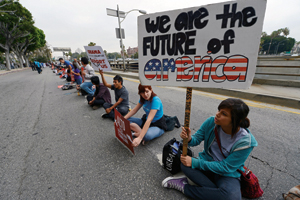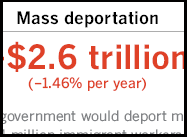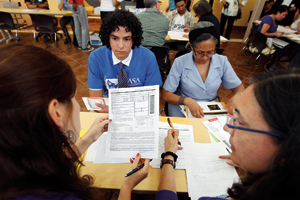CQ WEEKLY – COVER STORY
Nov. 24, 2012 – 11:56 a.m.
The Economics of Immigration
By David Harrison, CQ Staff
The immigration debate has a new argument.

|
||
|
For the past few years, those who favor allowing illegal immigrants a path to legal residence and eventual citizenship have based their campaign on moral grounds, that it is only fair and humane to bring the millions of undocumented immigrants out of the shadows, where they often are mistreated and underpaid.
Those who oppose such a path to legality have countered with a more politically powerful assertion, that illegal immigrants take jobs from Americans and, in their millions, threaten to ruin the country and its economy.
Now, though, at the moment when President
What’s been mostly lost in the political back and forth in recent years is the considerable body of evidence that liberalizing immigration policies would, in fact, improve the U.S. economy. Experts and academics have run computer models of various legalization scenarios and found that they would all help brighten the nation’s economic prospects as it continues to struggle out of a recession.
“Putting these young people to work is good for the economy and creates jobs, just the opposite of what many people have argued,” says Sen.
“Bringing these people out of the shadows who are undocumented,” Durbin says, “having them pay taxes, having them pay for the protection of basic laws, these things are good for the economy.”
Most economists agree that a mass legalization program would have a net positive long-term effect on the economy, and that agreement includes even Harvard’s George J. Borjas, whose studies of immigration and falling wages have long been cited by those who oppose more liberal immigration policies.
The macroeconomic effects of an immigration bill, it seems, are not in question.
The 1986 Simpson-Mazzoli Immigration Reform and Control Act, which gave a path to citizenship for illegal immigrants who had been in the country before 1982, had the effect of raising the wages of formerly undocumented workers by 15.1 percent within four or five years, according to one study commissioned by the Labor Department. That, in turn, boosted consumption and tax revenue.
“The economics is really clear,” says Jeremy Robbins, director of the Partnership for a New American Economy, a coalition of mayors and corporate CEOs that was co-founded by New York Mayor Michael Bloomberg to seek more liberal immigration policies. “If you get talented people here who want to work, the economy is going to grow. We don’t have a zero-sum economy. And the same is true at the low-skilled end.”
That doesn’t mean that every American’s life would be improved overnight. As with any significant policy shift, an immigration overhaul would create winners and losers, at least in the short term. Academics disagree over the details, in particular the question of whether the new influx of legal low-skilled labor causes wages for native-born low-skilled workers to drop.
The Economics of Immigration
And that is part of what worries immigration opponents such as
“Jobs are scarce and families are worried,” Smith said at a hearing last year. “Seven million people are working in the U.S. illegally. These jobs should go to legal workers.”
Nevertheless, even some Republicans are starting to probe a new path on the immigration debate, given the results of this month’s election. Sen.
“If your economy is demanding 2 million people a year to fill 2 million new jobs at a certain level, but you’re only allowing a million people to come in,” Rubio said, “you have a supply-and-demand problem, and that supply of folks that need a job in Mexico or anywhere else in the world is going to meet that demand.”
An Uncertain Pathway

|
||
|
When President Ronald Reagan signed the 1986 immigration law, he set in motion a process that would eventually put 2.7 million formerly illegal immigrants on the road to citizenship. First, the law granted them permanent residency visas — known as green cards—which also allowed them to bring immediate family to the United States. Over time, many of those green-card holders became naturalized citizens, woven into the fabric of the country.
Thanks to the law, immigrants were able to bargain for higher wages, pay taxes, build up their credit histories and apply for loans. Knowing that they were safe from deportation also made them more likely to learn English, get an education, buy houses and start businesses. They eventually settled down to raise thoroughly American children weaned on sugary cereals and Saturday morning cartoons.
“All around, it generated a burst in consumption as wages increased, but also in productivity, which is the economist’s dream,” says Raúl Hinojosa-Ojeda, a Chicano studies professor at the University of California, Los Angeles, and an influential pro-immigration voice. “When you create a wage increase for a lot of people in the economy, they start spending a lot more. And we are all people that sell to them, so our economic activity goes up.”
In a paper earlier this year for the free-market Cato Institute, which backed a more liberalized immigration system, Hinojosa-Ojeda estimated that a new immigration law similar to the 1986 overhaul would add $1.5 trillion to the country’s gross domestic product —roughly 0.84 percent — over 10 years.
A less-expansive change that would simply create a guest-worker program, rather than legalize all 11 million undocumented people living here, would only create $792 billion in added growth, while a mass-deportation plan would reduce GDP by $2.6 trillion, Hinojosa-Ojeda found.
Another Cato Institute study in 2009 found similar results. Restrictionist policies would harm the economy, while legalization combined with a visa tax assessed on immigrants would add $180 billion to the economy each year. And a report last month from the Center for American Progress — which was founded by President Bill Clinton’s chief of staff, John Podesta — reached a similar conclusion when looking at the DREAM Act, a more narrowly written immigration bill that would only grant a pathway to citizenship to the roughly 2 million young people brought to the United States illegally as children. The study estimated that passing the DREAM Act would generate $329 billion into the economy by 2030.
Many of those studies point to the 1986 law as evidence.
The Economics of Immigration
Cost to Consumers
Higher wages for a large swath of immigrants would also probably increase prices for consumers, making things like restaurant meals and lawn care services more expensive.
For instance, today, roughly 70 percent of farm workers are illegal immigrants, largely because American workers refuse to take farm jobs. If government policy grants the undocumented workers legal status, they will eventually look for better jobs in other industries. That means the farm industry will either have to raise wages and prices or continue to hire illegal immigrants. Neither of those is a good option.
Hinojosa-Ojeda says that although that may be true in the short term, over time, newly legalized workers would become more productive, which would offset the impact of their higher wages so that consumers would not notice much of a price change.
Other researchers say the economy’s need for a large pool of low-skilled, low-wage workers is the reason why any mass legalization proposal should include a revamped guest-worker program that would allow workers more say over their employment and working conditions.
“Because of our border with Mexico, you really have to accommodate the demand for that type of labor with legal pathways,” says Pia M. Orrenius, a senior economist at the Federal Reserve Bank of Dallas and a former adviser to the George W. Bush administration. “Those can be set up to work for the benefit of both countries. It’s not that difficult to set up working programs.”
“A lot of people don’t want to stay permanently,” she adds. An improved temporary-worker program would simply “reinforce the circular migration that was there for many decades.”
Needs of the Market

|
||
|
But guest-worker programs have traditionally been one of the thorniest parts of immigration policy. In 2006-07, when Congress last debated immigration legislation, labor unions opposed the guest-worker provision in the bill, saying the program would not be responsive to the needs of the labor market and would create a class of second-class workers with no rights and no hope of staying in the country.
“There has to be a rational, data-based way to determine when there’s a labor shortage,” says Ana Avendaño, the AFL-CIO’s immigration director. “And when that’s determined, employers should bring in workers to deal with those labor shortages. Those foreign workers should come in with full rights.”
Avendaño says she would favor a government commission that would use state-of-the-art labor market data to determine where the shortages are at any given point.
Recent immigration overhauls introduced by two Democrats, Sen.
The Economics of Immigration
Despite its net positive effects overall, legalizing the status of millions of undocumented immigrants would not benefit everyone equally, at least not right away. Low-skilled American workers, in particular, who have been hardest hit by the current downturn, could find themselves competing with millions of new job applicants.
“The official unemployment rate for native-born Americans without a high school degree is well over 20 percent, and their underemployment rate exceeds 32 percent. That’s also a third of that entire class of workers,” Rep.
“And yet at the same time, millions of illegal immigrants hold jobs,” added Gallegly, an outspoken critic of loosening immigration rules. “Even when low-skilled Americans can find jobs, their wages are depressed by illegals and other low-skilled immigrants.”
Gallegly and other conservatives often cite the work of Borjas, the Harvard economist who favors more restrictions on immigration. One of his most-cited studies found a link between an influx of immigrant workers and falling wages.
Between 1980 and 2000, Borjas has written, immigrants expanded the supply of working men by about 11 percent. That brought about a 3.2 percent drop in the wages of the average American worker. The effect was strongest among high-school dropouts, who saw their wages decline by 8.9 percent.
Borjas’ results have been challenged by other economists, notably Giovanni Peri at the University of California, Davis. According to Peri, though immigrant workers may have some small negative impact on native workers in the short term, they actually lead to higher wages for Americans over time. That’s because immigrants, many of whom do not speak English well, tend to take different jobs than native-born workers do. Immigrants will cluster in trades like construction, for instance, whereas low-skilled Americans will get jobs in manufacturing, he says.
That means immigrant workers and native-born workers complement each other rather than compete against each other. In a post for the Federal Reserve Bank of San Francisco, Peri provides an example: “As young immigrants with low schooling levels take manually intensive construction jobs, the construction companies that employ them have opportunities to expand. This increases the demand for construction supervisors, coordinators, designers and so on. Those are occupations with greater communication intensity and are typically staffed by U.S.-born workers who have moved away from manual construction jobs.”
Over time, many of those who would earn legal status would move up the economic ladder and compete with native-born workers for higher-skilled jobs, but at that point they would blend into the American workforce and make it more productive, Orrenius says.
“Is that really a negative? I don’t think we should call that a negative,” she says. “That productivity increase is part of economic growth, and that’s something that’s desirable. There was a time when they didn’t want women in the labor force because they didn’t want them to compete with men.”
Is There a Cost to Society?
Opponents of legalization contend that legalizing millions of low-income immigrants would drain social services. Sen.
“One of the bedrock legal principles of immigration is that those coming to America should not be reliant on federal assistance,” Sessions said in a statement this month. “That principle has been steadily eroded.”
During the 2006-07 immigration debate, the Congressional Budget Office found that the added costs of the legislation, especially its Medicare and Social Security costs, would outweigh the new tax revenue generated by the change. CBO reported that the 2006 immigration bill would have increased mandatory spending by $54 billion between 2007 and 2016, largely because of immigrants’ becoming eligible for entitlement programs. Discretionary spending also would rise by $25 billion from 2007 to 2011, while tax revenues would rise by $66 billion by 2016, which is not enough to offset the added costs.
The Economics of Immigration
But CBO acknowledged that its analysis did not take into account the possible economic growth that could occur after legalizing so many undocumented workers. That growth, the agency said, could boost tax revenues by anywhere from $80 billion to $160 billion between 2007 and 2016, which would compensate for the increased government costs.
There is another reason to believe that the increased use of entitlement programs would not put a substantial strain on the Treasury, Orrenius says. That’s because any immigration overhaul that makes it through Congress almost certainly would include more visas for high-tech workers, a change that has wide bipartisan support.
Those workers are more likely to earn higher wages, which means they’ll contribute more in taxes than the value of the social services they will receive. “High-skilled immigration is a big fiscal boon,” Orrenius says. “That balances out what is a fiscal cost on the low-wage, low-education side.”
So if a sweeping immigration overhaul is such a good idea from an economic point of view, why have advocates been so silent in making that case until now? The main reason seems to be that it is a nuanced argument that doesn’t play well in bumper stickers.
“The argument for low-skilled immigration is a longer-term argument,” says Robbins, of the Partnership for a New American Economy. “It’s a harder argument to make in a sound- bite context.”
Since the election, however, some Democrats have started relying more on the economic case. And they have been joined by some Republicans hoping to strike a deal that could make the GOP more palatable to Hispanic voters, a fast-growing voting block.
“People that are here, even those who are here illegally, if they’d like to work, we ought to figure out a way to let them work,” Sen.
Any grand bargain on immigration remains a long way off. But if members of both parties can agree on the macroeconomic merits of an immigration overhaul, they may find it easier to convince skeptical colleagues and the public at large.
FOR FURTHER READING: Path to citizenship, p. 2363; immigration and employment, 2009 CQ Weekly, p. 2860; Bush-era overhaul effort, 2007 Almanac, p. 15-9; 2006 Almanac, p. 14-3; 1986 overhaul, 1986 Almanac, p. 61.